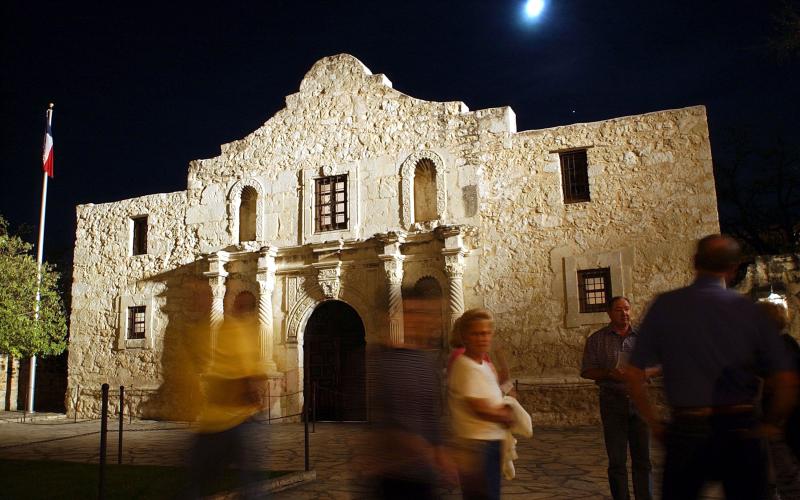Well, sort of.

The Alamo is crumbling, and it’s all my grandfather’s fault. That’s the distressing conclusion I reached after reading a report in the San Antonio Express-News last week about the massive effort underway in San Antonio to restore and preserve the 300-year-old Spanish mission and Texas Revolution battlefield. It appears that the limestone walls of the Alamo’s gable-topped mission church are literally falling apart, shedding bits of debris onto the floor. The primary culprit, according to experts, is the building’s air conditioning system, combined with the heat and moisture generated by the thousands of visitors who pass through each day. “The building was never intended to be that way,” George Skarmeas of Philadelphia-based Preservation Design Partners, which is leading the restoration effort, told the Express-News.
Where does my grandfather fit into this story? Well, Wallace Kerr happened to be the eponymous proprietor of San Antonio’s Kerr Air Conditioning, which in 1961 was hired—presumably by the Daughters of the Republic of Texas, which then operated the Alamo—to install the first A/C system in Texas’s most hallowed historic site. It must have seemed an appropriate choice, given that one of my grandfather’s ancestors had actually died at the Alamo. According to family lore (and corroborated by the official Alamo website), in 1836 brothers Joseph and Nathaniel Kerr of Louisiana joined a volunteer regiment of Texas revolutionaries and traveled to San Antonio. Nathaniel succumbed to illness shortly after arriving, but Joseph entered the Alamo on February 23 and died two weeks later during the battle; his name is engraved on the giant cenotaph in Alamo Plaza.
Our family has long prided itself on this bit of history. In Texas, having a relative who died at the Alamo is akin, or so one imagines, to being a Russian whose grandfather defended Stalingrad, or a Frenchman whose forebears fought under Napoleon. So the horrifying notion that the A/C system my grandfather installed is slowly destroying the Alamo was a major blow to my pride—could it really be true? After all, my grandfather died in 1979, before I was born, and the A/C system he and his employees installed has long since been replaced.
To determine my grandfather’s culpability for the Alamo’s lamentable condition, I decided to ring up Skarmeas, the leader of the restoration effort. “In the sixties, A/C became a commodity, and everyone was using it,” the Greek-born architect told me. “Nobody knew the unintended consequences. These things were done with all good intentions, without understanding what happens in a structure such as the Alamo church.”
In other words, my grandfather knew not what he did. That partly lets him off the hook, at least in my eyes, although perhaps it merely shifts the blame to the HVAC companies that later updated and eventually replaced the Alamo’s original system—and who perhaps should have known better.
The challenge today is reversing the damage inflicted on the church by 55 years of artificial cooling. “Buildings infiltrate and exfiltrate—they allow water vapor to move in and out in reaction to environmental conditions,” Skarmeas explained. “When you begin to introduce environmental controls, both heating and cooling, you ask the building to behave in a different way than it was intended to.”
Air conditioning systems create both temperature and moisture gradients between the inside and outside of a building. The steeper the gradient—the bigger the gap between indoor and outside temperature and humidity—the greater the condensation, which is air that has been chilled to its dew point and becomes water. (Think of the droplets that form on your cold Dr Pepper in the summer.) According to the American Society of Heating, Refrigerating, and Air-Conditioning Engineers, “if a wall is not designed for the anticipated indoor/outdoor moisture gradient, or if the indoor humidity is higher than the building design contemplated, moisture can condense inside the wall. That moisture can eventually cause structural damage.”*
What can be done to save the Alamo? Among the options under consideration by Skarmeas’s team is reducing the reliance on air-conditioning by allowing the building to remain slightly hotter in the summer. “Is it necessary to go to this iconic space and have the difference between inside and outside be 100 degrees and 70 or 75 degrees?” he asked. “Would it be acceptable to have it be 85?” (To be fair, that’s the equivalent of a cool fall day for many Texans.)
The most radical option of all would be to remove the A/C entirely and return the Alamo to the conditions under which Travis, Crockett, and Bowie experienced it. “A heavy stone building like the Alamo is really intended to stay cooler in hot climates than a regular frame building,” said Elizabeth Porterfield, a former architectural historian at San Antonio’s Office of Historic Preservation who now works at the Austin environmental consulting group Hicks & Company. “The thick walls help keep out heat in the summer and retain heat in the winter. There are high ceilings, which allows hot air to rise, and the doors and windows are aligned for cross-ventilation.”
Maybe air-conditioning the Alamo was just another of those inspiring, hubristic, and ultimately pointless exercises in national self-aggrandizement that America seemed to favor in the sixties, like putting a man on the moon or creating the Monkees. My grandfather Wallace, perhaps inspired by the sense of optimism embodied in President Kennedy’s inaugural address, might have imagined that making the Alamo comfortable for summer tourists was what he was called to do for his country. And who am I to say he was wrong? After all, it’s been wonderfully temperate during my visits.
*Correction: A previous version of this article inaccurately described the way the A/C unit was affecting the Alamo’s 300-year-old limestone walls. We have since updated the description and regret the error.
